History or heritage: A Museum for Football in Australia
This article appeared in Leopold Method in May 2015 just after the launch of the Whole of Football twenty year plan by Football Federation Australia.
The reference is: Roy Hay, ‘History or heritage: FFA Plans for a History Museum’, Leopold Method, 13 May 2015, http://leopoldmethod.com.au/ffa-football-museum/
Football Federation Australia launched its whole of football strategy for the next twenty years on 5 May 2015. Among the many targets of the document is a national museum for the code.
‘In the future football will celebrate our history. Football must establish a Football Museum to acknowledge the history of Football in Australia and establish a strong connection between Football’s present and its past’. (p. 23)
The photograph above is of the Australian squad which attempted to qualify for the World Cup in England before leaving for Phnom Penh in 1965. Back row, left to right: Jim Bayutti, manager, Ian Brusasco, ASF official, Nigel Shepherd, Billy Rice, John Roberts, Billy Rorke, John Watkiss, Les Scheinflug, Billy Cook, Lou Lazzari, masseur, Tiko Jelisavcic, coach. Middle row: Pat Hughes, Ian Johnson, Archie Blue, Roy Blitz, David Todd, Johnny Warren. Front row, Geoff Sleight, Ron Giles, Hammy McMeechan, John Anderson, Jim Pearson, Steve Herczeg, Stan Ackerley. Source: Laurie Schwab collection, Deakin University Library.
The game is still recovering from the attempted complete break with its past which marked the follow up to the Crawford Report, the replacement of Soccer Australia by the FFA and the NSL by the A-League, branded as ‘new football not old soccer’. Now those involved at all levels are prepared to recognise and accept that past and its many positive and negative elements, but serious questions arise about what should be done and how it should be done.
‘More than this, a Home of Football will allow Australia to look to the future, while also celebrating our Football history by encompassing a Football museum. It will act as a focal point for the whole Football Community’. (p. 110)
Nowhere in the document is the target fleshed out. It remains one of the elements where football’s aspirations outrun its resources. So what is the way forward?
Museums are expensive institutions, both to set up and run, and several sports museums have failed to establish viability, here and overseas. The National Football Museum in England, one of the best anywhere, was struggling in northern Lancashire, where it was attached to Preston North End’s Deepdale Stadium. The City of Manchester came to rescue by donating the Urbis building in the CBD and providing seed money to relocate. Now it is drawing around half a million visitors each year (480,000 in the year to 31 March 2015) and generating an estimated £25 million for the City of Manchester economy, at least £8 for every £ invested. The Museum has free entry, National Lottery support, and has a huge range of exhibits, both permanent and changing. The Preston facility remains as the research centre containing the archival collections built up over the years, so researchers as well as the general public are catered for.
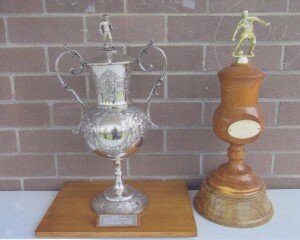
The Joadja Cup or the Atkinson-Price trophy, believed to be the oldest extant trophy for football in Australia, with the modern version used at the celebration game..
It is interesting that the club museum at Manchester United’s Old Trafford was concerned about some diminution in paid patronage when the NFM opened in 2012, but has instead found that numbers are increasing. Back in 2000 it was already drawing 150,000 visitors a year. Most of the leading European soccer clubs have their own museums, but many of them function more as visitor centers, serving the public relations needs of the clubs, than as sports museums proper.
FIFA is about to open a World Football Museum in Zurich early in 2016. Noises coming out of Switzerland are mixed. At the heart of the museum will be the permanent display of the original FIFA World Cup Trophy. ‘This is our Mona Lisa’ says the Creative Director of the Museum, David Ausseil, of the most famous trophy in the world (sic) ‘and it is exciting that fans will always be able to see it in its new home.’ But the website has the current trophy alongside the announcement, not the Jules Rimet original.
Highlights of the activities the Museum will offer include a cinema recreating the atmosphere of a stadium, and a Game corner with a newly created giant football Pinball machine. ‘We will have the biggest collection of football books in the world and academics and journalists will have access to material to help shape a better understanding of the history of the game. There are facilities for school trips and areas for academic seminars and conferences. This will be a museum fit for the 21st century’.
Here in Australia we already have the National Sports Museum at the Melbourne Cricket Ground. This is organisationally linked with the Melbourne Cricket Club Library and together they form a fine example of what is possible; blending a permanent collection of information about sports, regular special feature exhibitions, the sale of books and artefacts, and the superb archival research and bibliographic facilities of the Library. I have to declare an interest since the MCC Library houses the Roy Hay & Peter Desira research collections of books, newspapers and research material relating to Association football. Combined with tours of the ground these resources provide an admirably broad range of experiences for the general public, the curious sports buff and the professional researcher. The downside from a football perspective is that the Museum has one small window on soccer and the rest is largely AFL, with a smattering of the rugby codes.
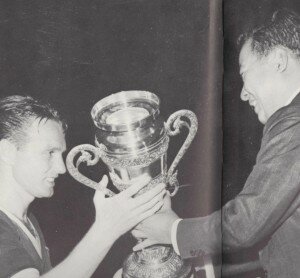
Les Scheinflug accepts a trophy presented by Prince Norodom Sihanouk of Cambodia after the World Cup qualification games against North Korea in 1965.
I asked Kevin Moore, the Director of the NFM in England about the way forward and specifically whether a centralised or a series of local institutions was the way forward. His advice is:
‘Small steps to show interest such as a showcase or area in a major museum is a good start. And the game should have more presence in the National Sports Museum.
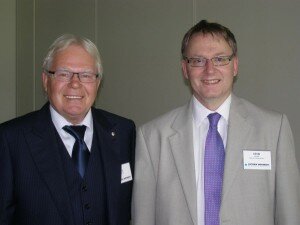
Les Murray of SBS and Kevin Moore of the National Football Museum in England at the Worlds of Football Conference at the MCG.
I understand the geography issue in having one site, but multi small sites is hard to pull off, and I can’t think of any sport that has done this successfully. But this could work if you could get spaces (cases?) in major museums in different cities, at least as a starting point. The benefit to non-sports museums in housing you is that it will bring them a new audience!
For me, the first step in parallel would be establishing a good website that is called the ‘football museum’ and showcases the collection. At least then you have a virtual museum to build upon.
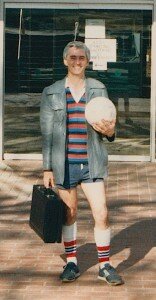
Wray Vamplew, the leading sports historian, with briefcase and ball after playing football on the MCG at a Sporting Traditions Conference.
Wray Vamplew, leading sports historian, who has researched and written on museums and halls of fame around the world, says ‘I think you have to balance out state rivalries and the costs of replicating venues across Australia. A no brainer I think. With the venue make sure it doesn’t have to be closed on match days like the Scottish Museum at Hampden. Also it would be good to emulate the NFM and establish a research archive’.
What is the purpose of a museum. Is it celebratory or critical? Museums of sport often differ from Halls of Fame in being less sports specific and having more clearly defined archival and research functions. Nevertheless critical scrutiny of such museums is constantly required both for the intellectual health of the curators and for the edification of the patrons, lay and professional. Factual accuracy is usually a prime goal but broader cultural and ideological concerns may not be constantly addressed and interrogated. As Wray Vamplew put it, ‘Unfortunately, too many of the smaller museums are run by enthusiastic collectors trained neither in curatorial skills nor as sports historians, which results in the presentation of artefacts without adequate explanation and a failure to set them in their appropriate social, economic or political setting. Sports museums inhabit that part of the sporting world obsessed with winning, and generally give insufficient recognition to either participation or that most typical of sports experiences—losing.’ Richard Cox pointed out in 1996 a danger with the proliferation of museums is that few of them will be able to be self-sufficient thus putting their collections in constant danger of being broken up or sold off or simply disappearing. Depending on a few enthusiasts is a recipe for long-term disaster.


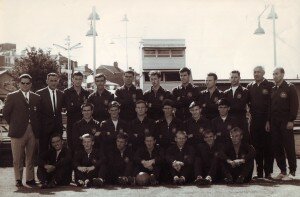
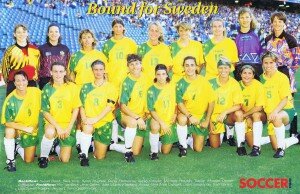
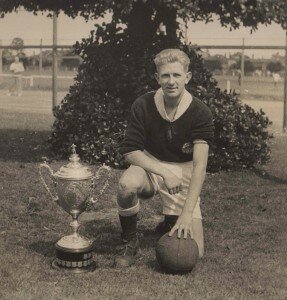






Marnie Haig-Muir: Your review of the latest Rankin is right on the money, Roy. This book...